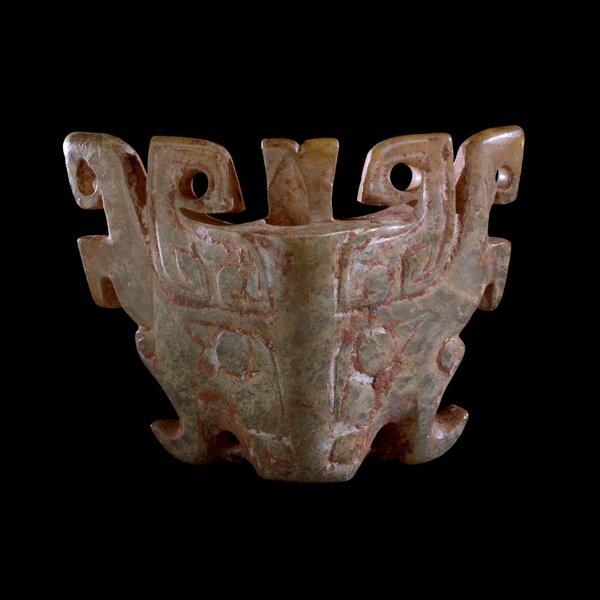Jade pendant in the shape of an animal face, China, Shang dynasty, around 1200 BC

Jade pendant in the shape of an animal face, China, Shang dynasty, around 1200 BC. Height: 3.400 cm - Width: 4.600 cm - Depth: 1.200 cm. On loan from a private collection, OA 12:16. Private Collection © 2003 Private Collection.
During the Shang (about 1500-1050 BC) and early Western Zhou (1050-771 BC) dynasties, small jade carvings in the shape of animals were made in large numbers and in a wide variety of forms. Their earliest appearance seems to be in the Anyang period, at the time of Fu Hao (around 1200 BC), the consort of a Shang-dynasty king. She was a formidable woman, who led armies into battle and conducted peace treaties. Her tomb, found in 1976 at Anyang (the major centre of the Shang dynasty from about 1300 BC, in Henan province, northern China), is the only royal tomb there to be discovered unrobbed. It contained over 750 jade artefacts, several of which were Neolithic. They may have been collected by Fu Hao on her travels and conquests.
The sharp angle dividing this animal face down the centre indicates that it may have been carved from a section of a cong. The wide corner of the original cong is seen at the top of the face, and small vertical plumes may have been carved from the collar.The inside of the carving is curved. If each side of the face is looked at separately from the whole, it is possible to make out the profile of a dragon with open jaws, coiled horns and tail.
J. Rawson, Chinese jade: from the Neolith (London, The British Museum Press, 1995, reprinted 2002)

/https%3A%2F%2Fprofilepics.canalblog.com%2Fprofilepics%2F1%2F0%2F100183.jpg)
/https%3A%2F%2Fstorage.canalblog.com%2F03%2F02%2F119589%2F96711876_o.jpg)
/https%3A%2F%2Fstorage.canalblog.com%2F11%2F31%2F119589%2F94773502_o.jpg)
/https%3A%2F%2Fstorage.canalblog.com%2F20%2F83%2F119589%2F94772815_o.jpg)
/https%3A%2F%2Fstorage.canalblog.com%2F26%2F72%2F119589%2F75604929_o.jpg)
/https%3A%2F%2Fstorage.canalblog.com%2F59%2F60%2F119589%2F26458628_o.jpg)


/http%3A%2F%2Fstorage.canalblog.com%2F05%2F64%2F119589%2F128523518_o.jpg)
/http%3A%2F%2Fstorage.canalblog.com%2F78%2F46%2F119589%2F127133605_o.jpg)
/http%3A%2F%2Fstorage.canalblog.com%2F99%2F82%2F119589%2F126892955_o.jpg)
/http%3A%2F%2Fstorage.canalblog.com%2F51%2F84%2F119589%2F122518624_o.jpg)